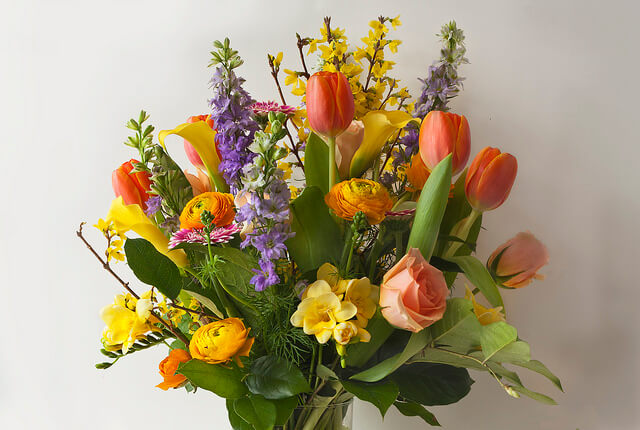
A well-planned cutting garden can bring pleasure in your home throughout the growing season. Liz West photo.
We all enjoy the beauty and fragrance of flowers in our yard. If you also take pleasure in having flowers in your home, you may want to plant a cutting garden.
Flowering plants give your garden an extra advantage: they attract beneficial insects. Beneficial insects, such as native bees and ladybugs, may pollinate your other plants or eat problem insects such as aphids.
Here are a few thoughts about choosing the right plants for your garden and maintaining them.
Choose a variety of bulbs, annuals, perennials and flowering trees and shrubs. For example, fall bulbs such as daffodils and tulips are dying back now. You could plant annuals among the bulbs to take over while the bulb foliage fades and dies.
Annuals are easy to grow, but die back after a year. Perennials provide blooms each year, but they often don’t continue to bloom over the entire season. Trees and shrubs may not only provide flowers during the growing season, but their branches may provide visual interest in the winter. Some shrubs flower in winter.
Consider color. A riot of color is less pleasing to most eyes than a few colors. Choose a color scheme or two, and group plants in the garden by compatible colors.
Consider the site. Most flowers needs six to eight hours of sunlight daily.
Think about watering. Many flowering plants need regular water. Plant the garden where you can easily water it as needed, or use drip irrigation to make watering easier. A thick layer of mulch will help the soil retain water.
Cut flowers regularly so the plants continue to bloom. Cut them when they are partly open; they will last longer in the vase. And cut them when it is cool, such as morning. Leave them in a bucket of cool water for several hours before arranging them into a bouquet.
Recommended plants for the cutting garden
Here is a list of recommended flowers for the cutting garden from Catherine Mix.
- Early-summer bloomers: Asiatic lilies, callas, columbine, foxtail lilies, peonies.
- Blues: Catmint, clematis, delphiniums, peach-leafed bluebell, Siberian iris.
- Whites: Dame’s rocket, Verbascum bombyciferum ‘Silver Lining’ (in bud), Nicotiana x sanderae ‘Fragrant Cloud’, roses, white valerian.
- Yellows: Columbine, Phlomis russeliana.
- Fragrant flowers: Anise hyssop ( Agastache foeniculum), mignonette ( Reseda odorata), nicotiana, old-fashioned roses, Oriental lilies, sweet peas.
- Fillers: Chamomile (before bloom), fennel (flowers), lady’s-mantle.
- Self-sowers: Baby blue eyes, columbine, mullein, poppies, valerian, Verbena bonariensis.
The Seattle Urban Farm Company recommends cosmos, dill, marigolds, nasturtiums, nigella, snapdragons, sunflowers, sweet peas and zinnias. These are all easy to grow and reliable.
Rainy Side Gardeners has an extensive list of cut flowers to grow in the Pacific Northwest, with links to growing recommendations for each variety.
Plant sales: a great place to buy cutting garden plants
This is a great time of year to plant a cutting garden. Many organizations and garden clubs have plant sales in May. Here is a calendar of plant sales, including dates, locations and sponsoring organizations, from the University of Washington Botanic Garden.
